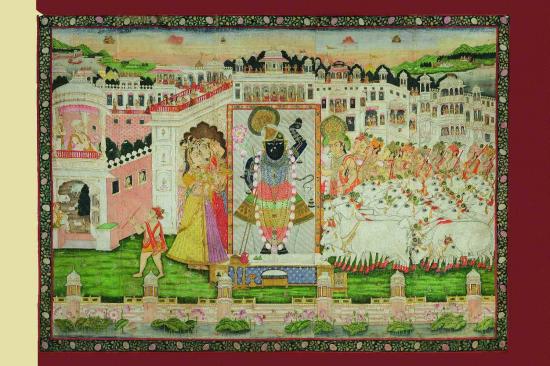
About 40 pichhwais were displayed this year at the National Museum in New Delhi. The exhibition was a collaborative effort of the National Museum, New Delhi with the Textiles and Art of the People of India (TAPI), Surat. The theme of the exhibition was “In Adoration of Krishna—Pichhwais of Shrinathji,” Later this exhibition travelled to Mumbai and Surat.
The exhibits were handpicked from the 80-odd pieces that were acquired by Praful Shah and Shilpa Shah for the TAPI collection over a period of 20 years. Their collection covers the entire 300-odd year period for which this art form has been in existence. The TAPI collection has an incredible array of textile-related art from all over the world.
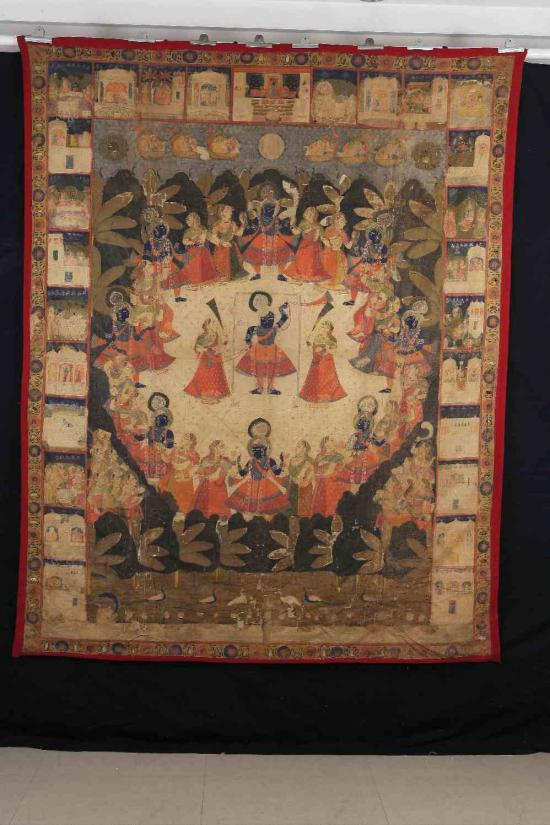
Pichhwais represent a unique form of textile art which originated at Shrinathji temple in Nathdwara a little over three centuries ago. Nathdwara is some 48 km northeast of Udaipur in the Rajsamand district of Rajasthan.
The temple dedicated to Lord Krishna was named Nathdwara because Lord Krishna is also known as ‘Nath’ and ‘Nathdwara’ means ‘Gateway to God.’ Nathdwara is believed to be one of the richest Hindu temples in India next only to Tirupati Devasthanam in Andhra Pradesh.
Pichhwais are large devotional cloth hangings which form the background for Lord Krishna’s icon in Pushti Marg temples. Pichhwai literally translates to ‘at the back.’ Traditionally, pichhwais were painted on woven cotton cloth. The cloth used to be coated with a mixture of gum Arabic and rice floor to create an even surface. Colour pigments obtained from vegetables and minerals were then applied on them with a brush.
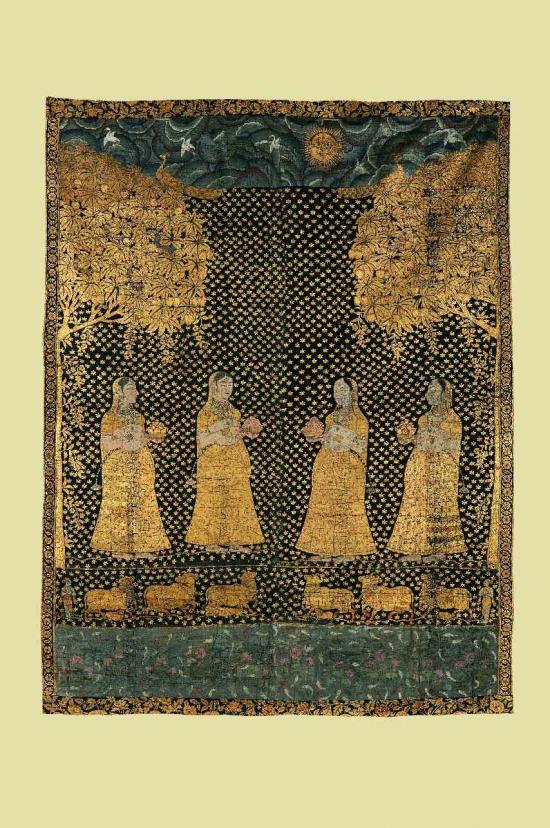
Pichhwais usually depict 24 scenes from Lord Krishna’s life related to some festival or holy day. At the centre of these pichhwais is either a stylized image or a symbolic representation of Lord Krishna. Dark clouds, dancing peacock, Kadamba tree etc. symbolize Lord Krishna in these paintings. The pichhwais are changed from time to time depending upon the day, season and occasion to create different moods and ambience.
Lord Krishna is the most loved of the nine incarnations of Lord Vishnu for his childhood antics and pranks; his stories of love, friendship and fight against evil forces during his adolescence as a cowherd; and, his philosophical discourses and political manoeuvres as the charioteer of Arjuna, one of the greatest warriors of Mahabharata fame.
Lord Krishna’s personality was so popular and powerful that everything associated with him has been immortalized in art, literature and culture of India. Butter, flute, peacock feather, cows, cowherds, milkmaids—literally everything associated with Lord Krishna has left an indelible mark on our culture.
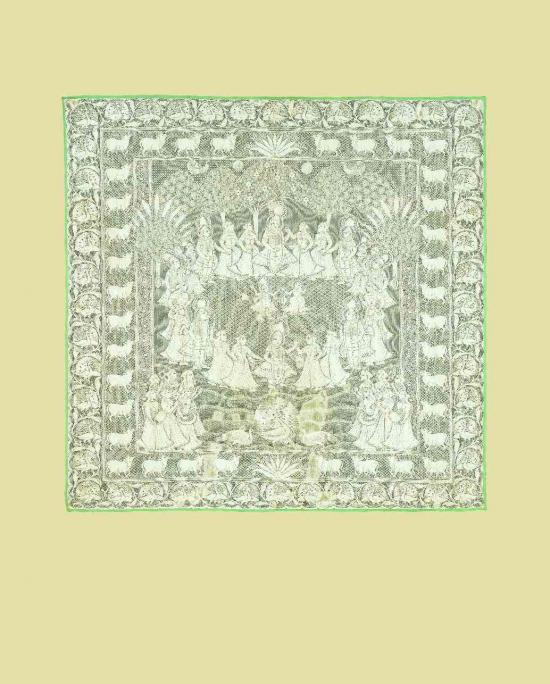
Srinathji is the presiding deity of the Pushti Marg sect which worships Lord Krishna in the form of a child divinity. The Pushti Marg was founded in the sixteenth century by Vallabhacharya (1479-1531) who was also known a Mahaprabhuji. Pushti Marg means “The Path of Grace.” It is a vaishnavite sect whose cult figure is Lord Krishna. The Pushti Marg sect worships Lord Krishna as a living child divinity.
Together with Shankaracharya, Ramanujacharya, Madhavacharya and Nimbarkaracharya, Vallabhacharya was one of the five main acharyas of the Bhakti movement which led to the resurgence of Hinduism in India in the medieval period.
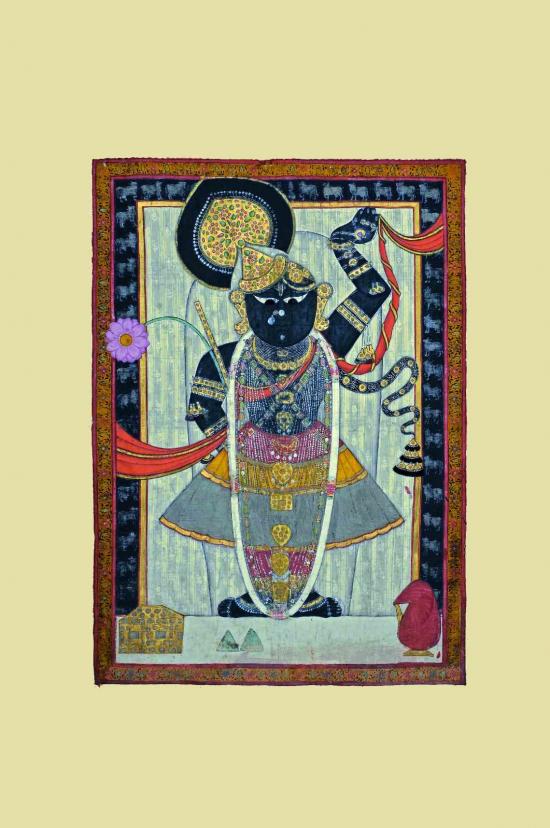
The black stone image of Shrinathji in Nathdwara was originally consecrated by Vallabhacharya in Mathura which is the birth place of Lord Krishna where decorative clothes were used as backdrop for the image.
Fearing vandalism by Aurangazeb in 1691, the Pushti Marg sect in Mathura decided to shift the image of Shrinathji to a safer haven. The image of Shrinathji was sent to Udaipur (the capital of Mewar in Rajashan) which was believed to be a safe sanctuary for the image. Mewar was the only region in northern India which did not yield to Mughal onslaughts.
However, the wheels of the chariot carrying the image sank into the ground at Nathdwara about 48 km northeast of Udaipur. No matter what the custodians of this image did, the wheels of the chariot would not move. Taking this as a divine signal, Srinathji’s temple was raised at the same spot where it stands to this day. Before construction of the temple this place was called Sihar.
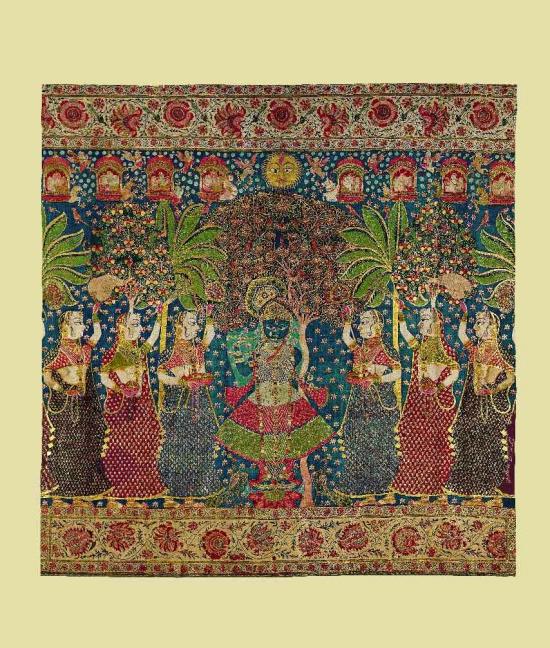
The image of Shrinathji in Nathdwara portrays Lord Krishna as a seven year old child. Since he is worshipped as a living god, his devotees treat him as he would have been treated by his parents at Nandgaon in Braj where he spent his childhood. That is why his shrine is called a haveli and not a temple.
The pichhwai depicting the image of Lord Krishna flanked by milkmaids against the backdrop of plantains executed in Kishangarh style belonging to late 19th century is pigment painted and is used during Sharad Purnima. Lord Krishna with cows around him against red background is an embroidered version made by Mochis from Gujarat. These are executed in chain stitch embroidery.
The pichhwai from Machilipatnam belonging to early 19th century represents the kalamkari style. The late 18th century gold painted pichhwai from the Deccan is used during Varsha. The pichhwai showing Ras Lila brought from Nottingham belonging to late 19th or early 20th century has been prepared using lace making machines.

In south India, pichhwai tradition existed in the Coromandel Coast and the Deccan. These are believed to have been commissioned by wealthy Gujarati businessmen who migrated to these areas and settled there. The gold painted Deccan pichhwais reveal the affluence of the patrons. The pichhwais from the Coromandel Coast are dyed and painted using kalamkari technique.
Pichwais are executed with such finesse that viewing a pichhwai is believed to transport the viewer right into the era of Lord Krishna. Pichhwais are truly the divine art of Nathdwara!



